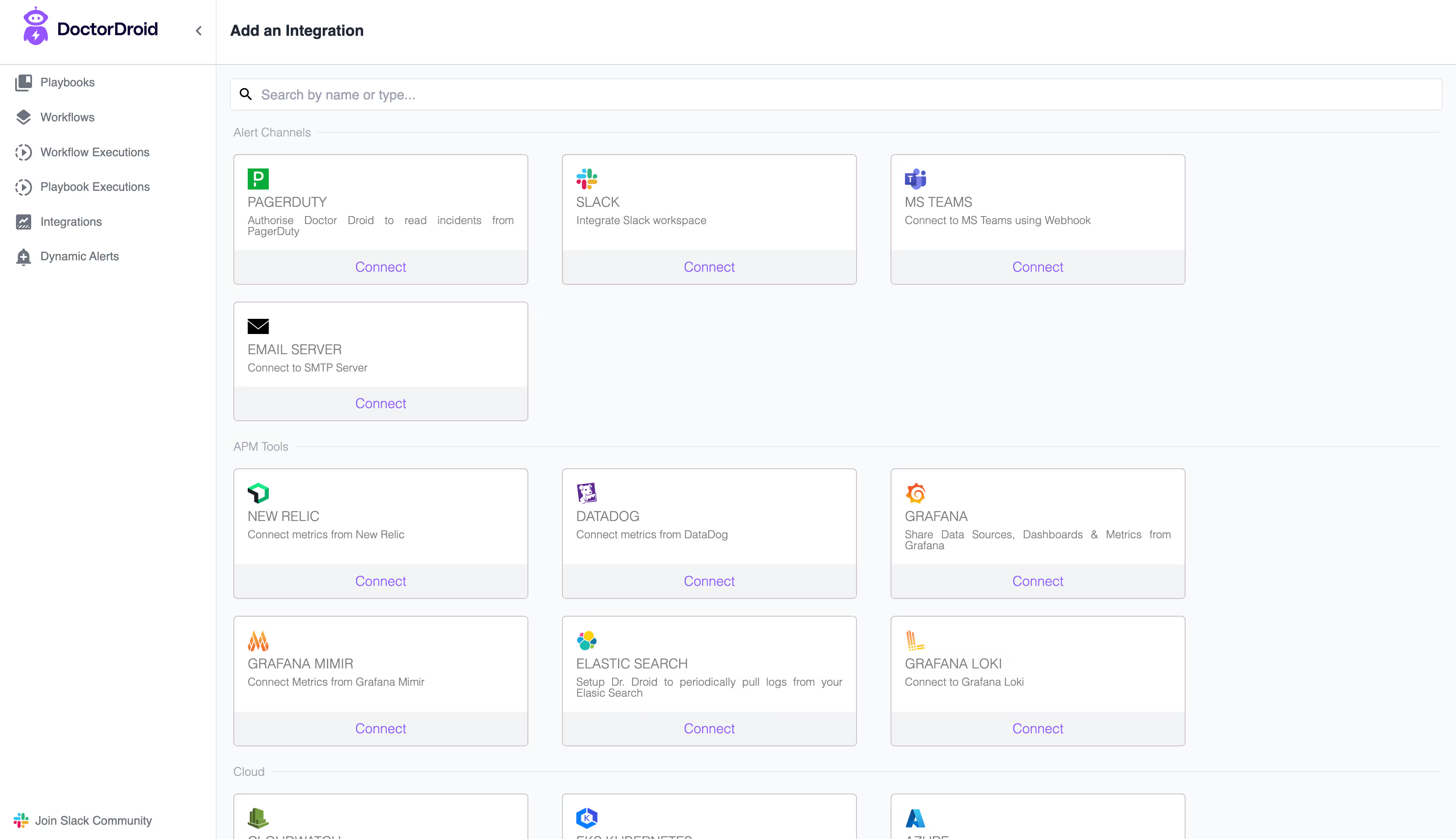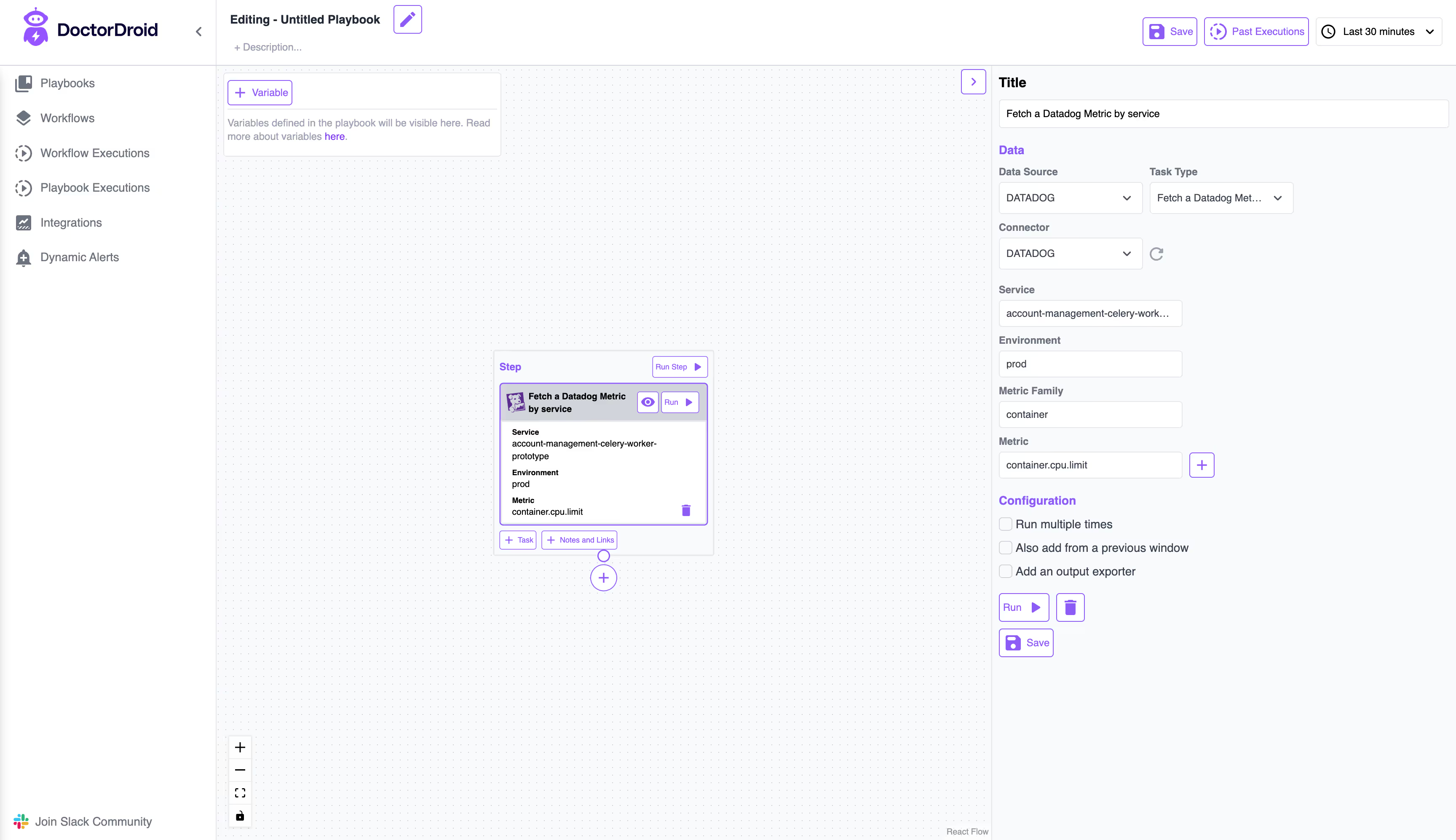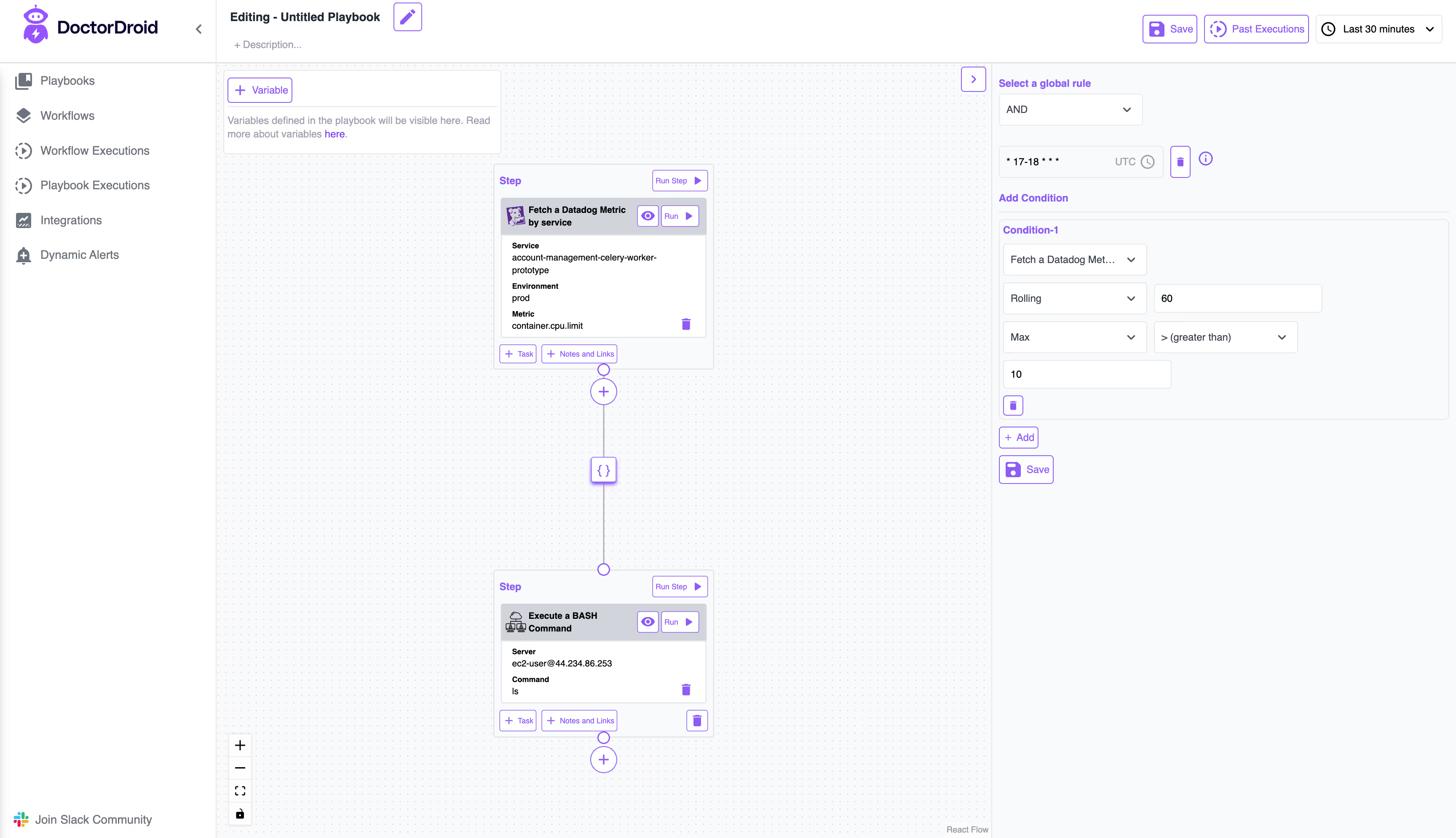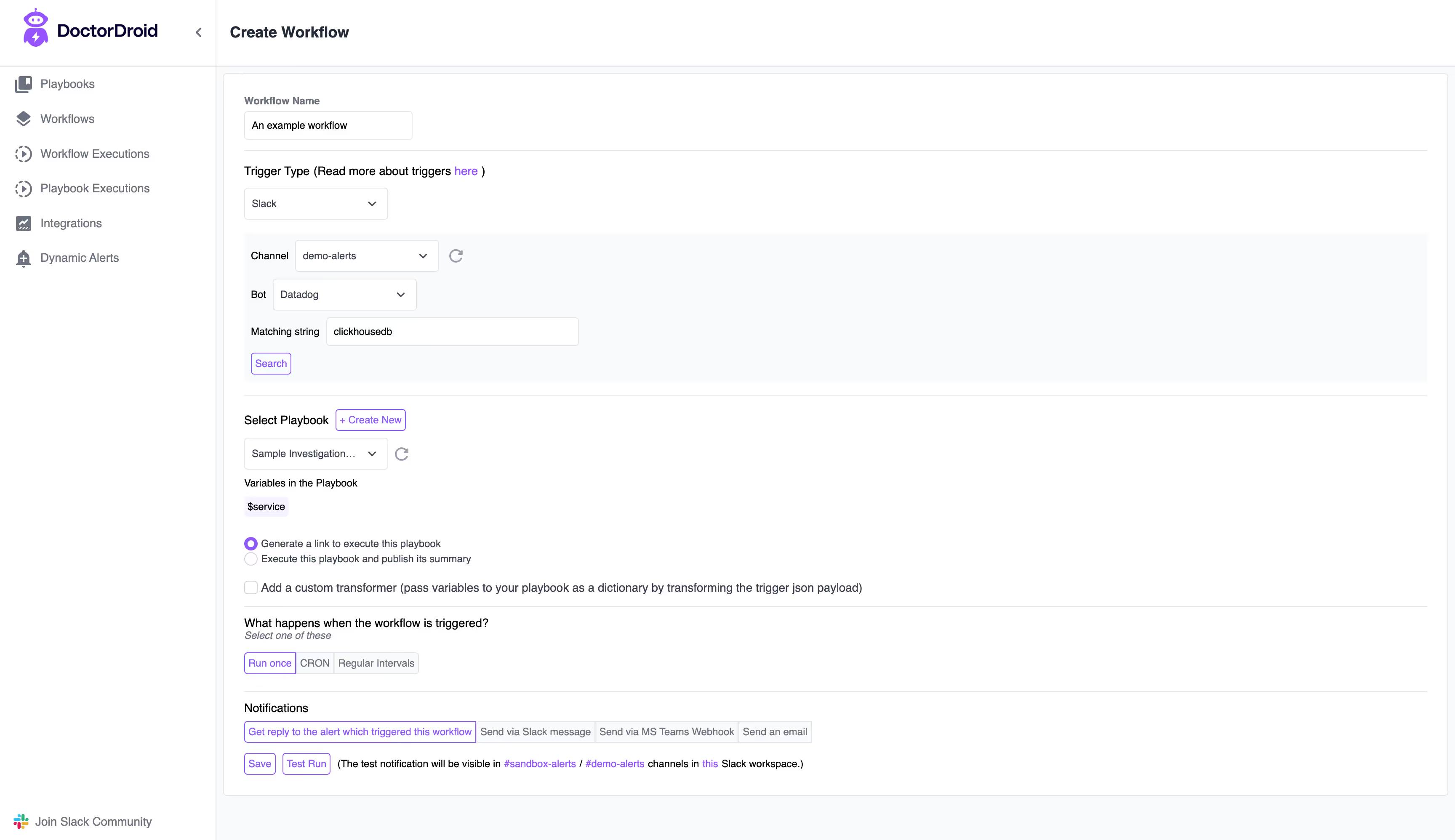Automating routine tasks is essential for maintaining reliable and efficient IT systems. Runbook automation takes repetitive processes and turns them into automated workflows, saving time and reducing errors, especially in fast-paced environments.
This guide will show you how to use Doctor Droid Playbooks to automate runbooks and enhance your operations. Let’s dive into making your workflows smarter and more efficient.
A runbook is a step-by-step guide that helps engineers troubleshoot and resolve common IT issues. Think of it like a recipe that lists all the ingredients and instructions needed to fix a problem, ensuring anyone can follow it to achieve the same outcome. Traditionally, runbooks have been manually executed, requiring engineers to perform each step by hand.
Automating runbooks transforms manual, repetitive tasks into automated workflows. This brings several key benefits:
With the right tools, such as Doctor Droid Playbooks, you can automate these runbooks, improve operational efficiency, and make your IT environment more resilient and manageable.

Doctor Droid Playbooks are powerful, automated workflows designed to streamline IT operations and incident management. These are dynamic workflows that can perform a series of predefined steps to resolve issues or carry out routine tasks without manual intervention.
Doctor Droid Playbooks are built to be flexible and user-friendly, allowing engineers to automate common procedures like restarting a service, clearing logs, or handling more complex incident responses. With an intuitive interface and robust integration capabilities, both beginners and experienced engineers can set up and deploy playbooks quickly and efficiently.
Doctor Droid Playbooks support several integrations that enhance their capabilities and expand their usefulness across different environments:
With Doctor Droid Playbooks, you can automate virtually any routine task or incident response, integrating seamlessly into your existing workflows. This flexibility makes them an essential tool for any DevOps or SRE team looking to enhance efficiency and reliability in their operations.
Getting started with Doctor Droid Playbooks is straightforward and empowering. Here’s a step-by-step guide to help you create your first automated workflow:
Before creating a playbook, ensure your Doctor Droid account is set up and integrated with the tools and systems you want to automate. You’ll need to:

Determine the task or incident you want to automate. This could be anything from handling a server outage to scaling cloud resources in response to increased traffic. A clear understanding of the workflow helps in structuring the playbook effectively.
Example Scenario: Let’s automate a response to a common issue, like restarting a service when a high CPU usage alert is triggered.
Now, it’s time to create your playbook in Doctor Droid:


Doctor Droid allows you to automate the execution of playbooks using workflows. These workflows can be set to trigger playbooks based on specific events or on a regular schedule:

Before deploying your playbook in a live environment, it’s crucial to test it:
By following these steps, you can create effective playbooks and workflows that streamline your operations and enhance your team’s efficiency. Doctor Droid makes it easy to automate repetitive tasks, whether they are scheduled or event-driven, allowing you to focus on more strategic work.
Doctor Droid Playbooks offer features that enhance automation capabilities, allowing teams to handle more scenarios efficiently. Here’s a look at some key features and their practical applications:
Doctor Droid allows you to set dynamic thresholds that adjust based on historical data and real-time analysis, reducing false positives and improving alert accuracy.
Use Case: For a web application with variable traffic, dynamic thresholds can adjust CPU usage alerts based on normal patterns, alerting only when there’s a genuine anomaly.

Integration with Slack enables real-time communication and incident management directly within the platform, keeping teams informed and coordinated.
Use Case: If a critical service fails, a playbook can automatically send an alert to a Slack channel, provide incident details, and facilitate team discussions and escalations without leaving Slack.
Doctor Droid automates tasks like restarting services or managing logs, reducing manual workloads and improving efficiency.
Use Case: During routine maintenance windows, a playbook can automatically clear log files or restart services as needed, ensuring that these tasks are completed consistently without manual intervention.
Runbook automation is essential for streamlining IT operations, reducing errors, and improving incident response times. Doctor Droid Playbooks provide a powerful solution for automating workflows, with features like seamless integrations with tools like Slack and the ability to manage routine tasks effectively.
Doctor Droid offers a user-friendly platform with robust automation capabilities, making it ideal for teams looking to optimise their operations. Its flexibility and intuitive design allow you to create customised solutions that fit your specific needs.
By choosing Doctor Droid, you're equipping your team with the tools to automate efficiently and maintain reliable, high-performance systems. Ready to enhance your automation efforts? Explore Doctor Droid today and start building your first playbook.
Try Doctor Droid — your AI SRE that auto-triages alerts, debugs issues, and finds the root cause for you.
(Perfect for DevOps & SREs)

Install our free slack app for AI investigation that reduce alert noise - ship with fewer 2 AM pings
Everything you need to know about Doctor Droid
Runbook automation is the process of converting repetitive IT tasks and procedures into automated workflows. It's important because it saves time, reduces human error, improves consistency, and allows your team to focus on more complex issues rather than routine tasks. For on-call engineers and SREs, this means faster incident resolution and more reliable systems.
Doctor Droid Playbooks provides a platform for creating, managing, and executing automated workflows. It allows you to codify your standard operating procedures, integrate with existing tools like Slack, and trigger automated responses to common incidents. This reduces manual intervention and helps maintain system reliability.
You can automate a wide range of routine tasks, including system health checks, resource scaling, backup procedures, user access management, alert response, log analysis, service restarts, and deployment processes. Any predictable, repeatable IT task is a good candidate for runbook automation.
Creating your first playbook with Doctor Droid is designed to be straightforward, even if you don't have extensive programming experience. The platform offers an intuitive interface that guides you through defining triggers, actions, and conditions. You can start with simple automation and gradually build more complex workflows as you become comfortable with the system.
Yes, Doctor Droid Playbooks offers seamless integration with common tools used by operations teams, including Slack, monitoring systems, ticketing platforms, and cloud services. These integrations allow you to automate workflows across your entire tech stack for comprehensive automation.
Runbook automations improve incident response times by immediately initiating diagnostic and remediation actions when issues are detected, without waiting for human intervention. They can gather relevant information, apply known fixes, and only escalate to on-call personnel when necessary, significantly reducing mean time to resolution (MTTR).
Advanced use cases include self-healing systems that automatically resolve common issues, intelligent escalation paths based on incident context, automated security incident response, capacity management, cost optimization processes, and complex multi-step workflows that span different systems and teams.
Runbook automation reduces errors by ensuring that procedures are executed consistently every time, eliminating the variability and mistakes that can occur with manual processes. This is particularly valuable during stressful incidents or when team members are handling unfamiliar systems.
Dr. Droid can be self-hosted or run in our secure cloud setup. We are very conscious of the security aspects of the platform. Read more about security & privacy in our platform here.
Dr. Droid can be self-hosted or run in our secure cloud setup. We are very conscious of the security aspects of the platform. Read more about security & privacy in our platform here.


